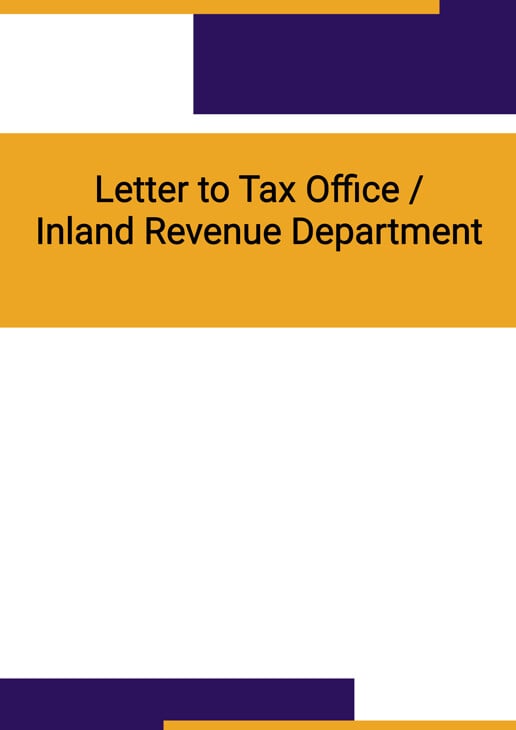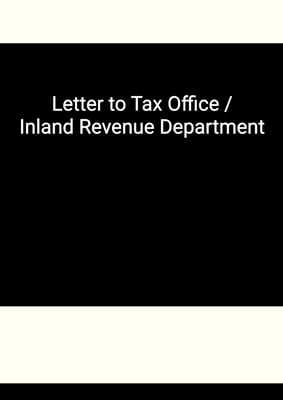How to Tailor the Document for Your Need?
01
Create Document
Click "Create Document" button and the document will be prepared with your account details automatically filled in.
02
Fill Information
Please fill in any additional information by following the step-by-step guide on the left hand side of the preview document and click the "Next" button.
03
Get Document
When you are done, click the "Get Document" button and you can download the document in Word or PDF format.
04
Review Document
Please review the document carefully and make any final modifications to ensure that the details are correct before sending to the addressee.
Document Preview
Document Description
The document titled 'Letter to Tax Office / Inland Revenue Department' is a formal letter written by an individual who is the director of a company. The letter is addressed to the Commissioner of Taxation or the Tax Office or the Tax Bureau or the Inland Revenue Department. The purpose of the letter is to provide clarification regarding the tax position of the company and to request the withdrawal of a tax invoice or a tax filing.
The letter begins with the sender's account information, including their first name, last name, and address. It is then addressed to the Commissioner of Taxation or the Tax Office or the Tax Bureau or the Inland Revenue Department, with the appropriate address. The sender requests the attention of a specific person by mentioning their first and last name.
The current date is mentioned in the letter, followed by a salutation that addresses the recipient by their title and last name.
The main body of the letter explains that the sender, as the director of the company, wants to provide clarification regarding a letter or a tax invoice received from the recipient's department on a specific date. The sender states that it appears to be a simple case of misunderstanding and explains why the name of tax or tax filing should not be applied to the transfer of ownership of the company. The sender provides reasons such as no real estate ownership transfer, no transaction, no profit made, and no tax presence.
The sender further explains that the company is a registered corporation engaged in business activity in a specific country. In a particular year, the company decided to engage in a transaction, and evidence of the transaction is attached for reference. The sender emphasizes that at the time of the transaction, there were specific facts that justified why tax should not apply, such as no assets in the company, no transfer of ownership, and no change of control.
In conclusion, the sender kindly requests the department to withdraw the tax invoice or the request for tax filing on the transaction, considering the reasons stated. The letter is signed by the sender's first name, last name, job title, and the name of the company.
Each section of the document serves a specific purpose. The introduction provides the necessary background information about the sender and the recipient. The main body of the letter explains the purpose of the letter, provides clarification regarding the tax position of the company, and presents evidence to support the claim. The conclusion summarizes the request and expresses gratitude for the department's consideration.
Overall, this document is important as it allows the sender to communicate with the tax authorities, provide necessary clarification, and request the withdrawal of a tax invoice or a tax filing.
How to use this document?
1. Enter the necessary account information: Fill in the sender's first name, last name, and address in the designated fields.
2. Address the letter correctly: Write the correct address of the Commissioner of Taxation or the Tax Office or the Tax Bureau or the Inland Revenue Department in the appropriate section.
3. Specify the recipient: Mention the first and last name of the person to whom the letter is directed, ensuring their correct title.
4. Include the current date: Write the date on which the letter is being sent.
5. Begin with a proper salutation: Use a suitable salutation that addresses the recipient by their title and last name.
6. Provide background information: Clearly state the purpose of the letter, which is to provide clarification regarding a tax invoice or a tax filing.
7. Explain the misunderstanding: Describe the reasons why the name of tax or tax filing should not be applied to the transfer of ownership of the company.
8. Present supporting evidence: Attach relevant documents that prove the absence of tax liability, such as evidence of no real estate ownership transfer, no transaction, no profit made, and no tax presence.
9. Highlight the company's registration and activity: Mention that the company is a registered corporation engaged in business activity in a specific country.
10. Explain the transaction: Provide details about the transaction that took place, including the date and any relevant information.
11. Justify the absence of tax liability: Clearly explain the specific facts that justify why tax should not apply, such as the absence of assets, transfer of ownership, or change of control.
12. Request the withdrawal of the tax invoice or tax filing: Kindly ask the department to withdraw the tax invoice or the request for tax filing based on the reasons stated.
13. Sign the letter: Sign the letter with the sender's first name, last name, job title, and the name of the company.
14. Proofread the letter: Review the letter for any errors or inconsistencies before sending it.
15. Keep a copy for reference: Make a copy of the letter for the sender's records and future reference.
Not the right document?
Don’t worry, we have thousands of documents for you to choose from:








